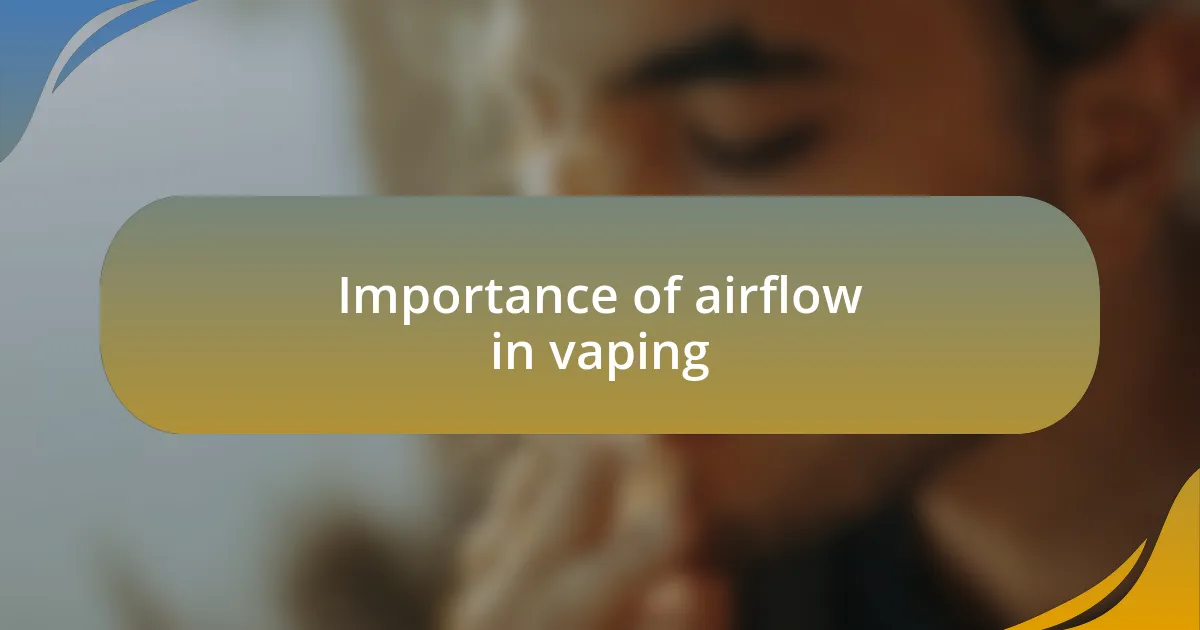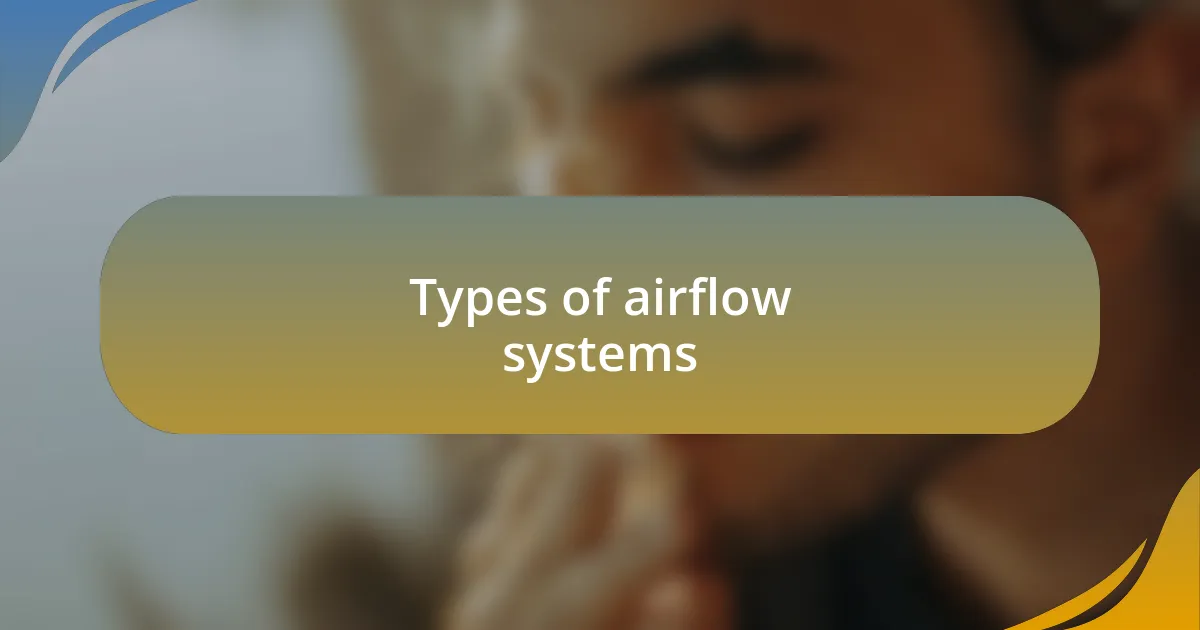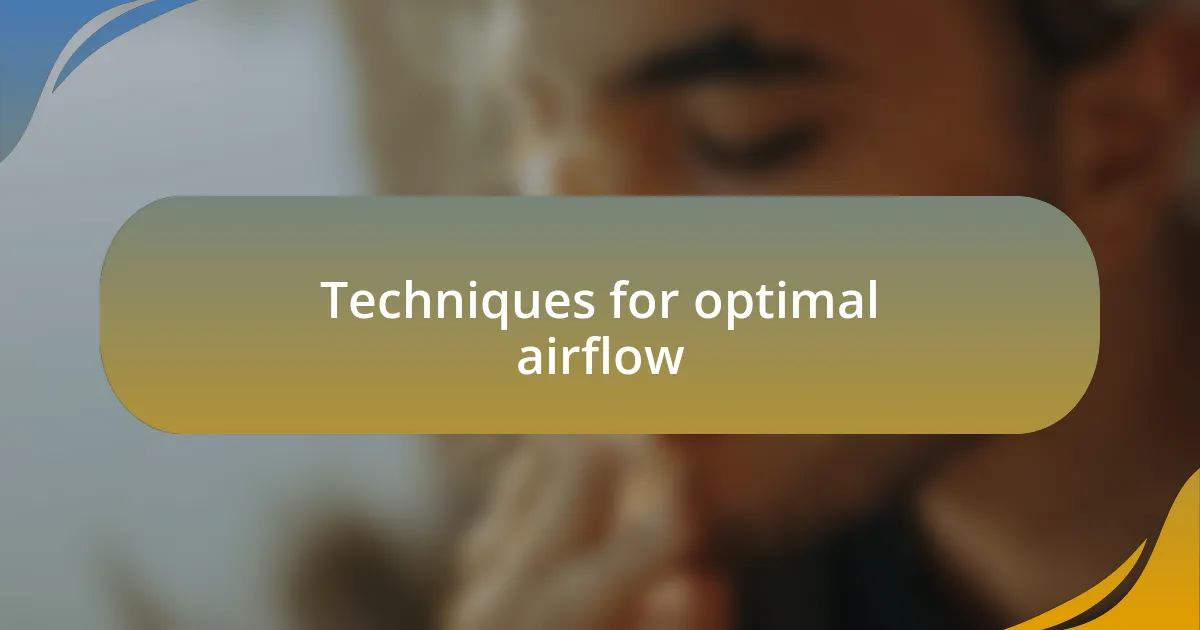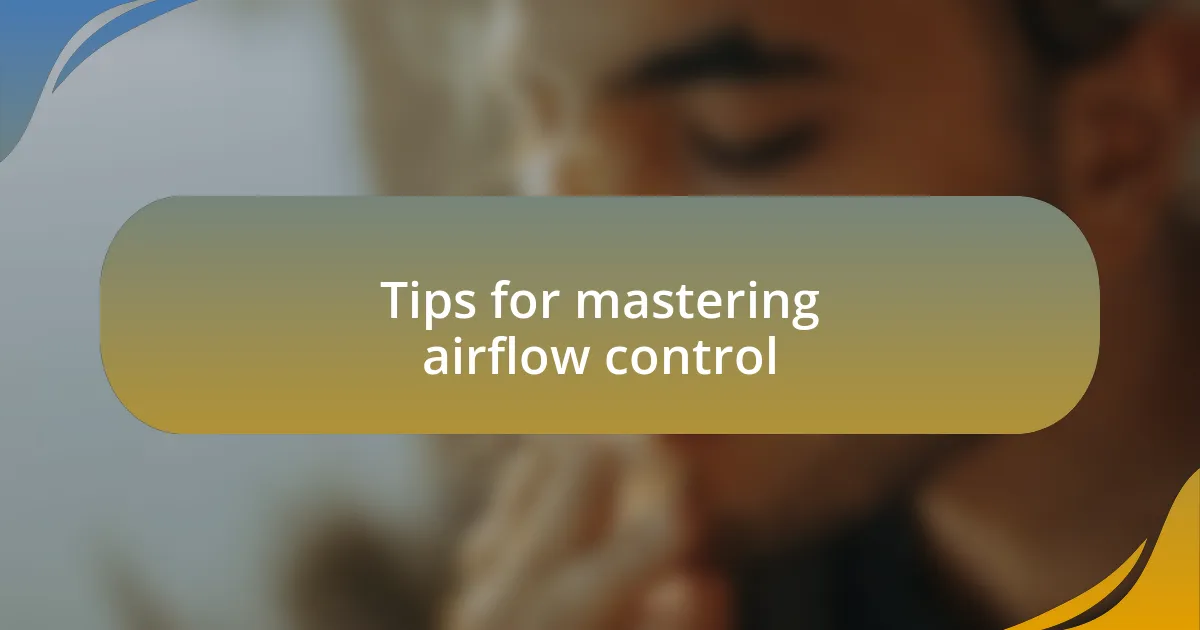Key takeaways:
- Airflow control significantly impacts vaping experiences by affecting flavor, cloud density, and overall satisfaction.
- There are three main types of airflow systems: adjustable, fixed, and hybrid, each offering different levels of customization and predictability.
- Measuring airflow can be done through techniques like observing draw resistance, using airflow meters, and tasting vapor to assess flavor nuances.
- Mastering airflow requires experimentation with settings, understanding device characteristics, and adapting to personal preferences and moods.

Understanding airflow control
Airflow control is crucial for maximizing the vaping experience. I remember when I first transitioned from beginner devices to more advanced setups, I was surprised by how much airflow affected flavor and vapor production. It’s fascinating to see how a simple adjustment can transform a bland vape into something truly vibrant.
Have you ever paid attention to how different airflow settings impact your satisfaction? I’ve found that tighter airflow enhances the flavor, giving me a richer experience, while wider airflow often produces denser clouds. It’s like learning to play with fire; the right touch can either ignite your senses or leave you feeling lukewarm.
Understanding airflow control involves more than just knowing the mechanics; it’s about finding personal preference and comfort. Through trial and error, I discovered my sweet spot and learned that a little tweak can cater to my mood, whether I crave a smooth inhale or an intense rush. It’s a journey of exploration, where each puff can teach you something new about your own preferences.

Importance of airflow in vaping
Venturing into the world of airflow really opened my eyes to how much it can shape the vaping experience. I vividly recall a session where I adjusted the airflow just slightly and suddenly my favorite flavor blossomed with new depth. It made me wonder: how many vapers are missing out on this simple yet powerful adjustment?
I discovered that the importance of airflow goes beyond just flavor; it directly impacts throat hit and overall satisfaction. On days when I sought something mellow and reassuring, a tighter draw would calm my nerves. In contrast, on more adventurous days, I embraced a wide-open airflow for that exhilarating rush. It’s incredible how a mere twist can evoke such different emotions.
What I find even more intriguing is how airflow preferences differ from one person to another. During group vaping sessions, I’ve seen friends argue passionately over their favorite setups. Some crave that airy draw, while others prefer the weighted richness of a constricted airflow. This reveals a personal connection each vaper has to their setup—it’s not just about vaping; it’s about self-expression and rediscovery with every puff.

Types of airflow systems
When discussing airflow systems in vaping, there are primarily three types: adjustable, fixed, and hybrid. I remember my first encounter with adjustable airflow—I was blown away by the versatility it offered. Imagine being able to tweak the draw to suit your mood, which for me ranged from the gentle caress of a tight draw to the exhilarating rush of a fully open system. It was as if I held a remote control to my own vaping experience.
Fixed airflow systems, on the other hand, seemed less appealing at first. I can still recall unboxing my first fixed airflow tank, wondering if I’d feel limited. However, I soon learned that for some, this simplicity translated to consistency. There’s something comfortingly predictable about knowing exactly what to expect from each puff, almost like enjoying a comforting routine in the chaos of daily life. Have you ever found solace in the familiar?
Then, there are hybrid systems that combine features from both adjustable and fixed airflow. They caught my attention because they promise a balance between customization and reliability. In one memorable session, I was able to dial in a setting that felt just right—like a perfectly brewed cup of coffee. This adaptability resonated with my ever-evolving taste, reminding me of the joy in exploring new flavors and experiences in vaping. Isn’t it amazing how the right system can transform not just the flavor, but the entire act of vaping?

How to measure airflow
To measure airflow in vaping devices, I found that observing draw resistance can be a key indicator. It’s intriguing how a little tweak can completely change the way the device feels during use. One method I’ve employed is inhaling lightly while covering the airflow holes briefly; this gives you a sense of what the airflow feels like with different adjustments. Have you tried this?
Another technique involves using an airflow meter, which can be surprisingly accurate. When I first used one, I remember being fascinated by the precise readings it provided, like having a backstage pass to my own vaping show. This tool helps quantify how much air is passing through, allowing for precise adjustments to achieve that perfect balance of flavor and vapor.
Additionally, I’ve learned that tasting the vapor can also offer insights into airflow performance. After one particularly satisfying session, I realized how changing the airflow could highlight nuanced flavors. It’s not just about the numbers; it’s about how those adjustments impact your overall experience. Do you ever tune into those subtleties? It’s moments like these that elevate vaping from a simple habit to a true craft.

Techniques for optimal airflow
Optimal airflow in vaping is all about balancing resistance and flavor. One technique I’ve found effective is adjusting the position of airflow slots. I remember the first time I tried this; it was like flipping a switch! Suddenly, the vapor became smoother, and the flavors popped with a vibrancy I hadn’t noticed before. Have you ever experienced such a shift just by moving a dial?
Another method I rely on is experimenting with different coil builds. Using lower ohm coils can significantly influence airflow, increasing vapor production while enhancing the throat hit. I recall a session where I switched to a dual-coil setup; the transformation was remarkable! The draw felt effortless, and I was enveloped in rich clouds that tasted delicious. It’s fascinating how such technical adjustments can lead to such satisfying results, don’t you think?
Additionally, utilizing the principles of direct lung and mouth-to-lung inhales can change the game for airflow control. I often find that switching between these styles not only affects my experience but also alters the entire flavor profile of the juice. It’s a refreshing approach that keeps each session exciting. Have you explored inhalation techniques? The interplay between technique and flavor truly makes vaping an art form.

My personal journey with airflow
My journey with airflow began somewhat unexpectedly. I remember my first experience trying different devices; the moment I adjusted the airflow ring on my tank, I was taken aback. It felt as if the entire world of flavors unfolded right before me, and I couldn’t help but wonder how such a small change could create such a big difference. Have you ever felt that rush of discovery?
As I delved deeper, I experimented with the airflow settings on my rebuildable atomizers. One specific instance stands out: I was trying a new juice, and suddenly, too much airflow made the flavor disappear. Frustration turned into intrigue as I realized how sensitive these adjustments could be. I began to understand that controlling airflow isn’t just about preference; it’s a science that directly influences my vaping experience. It’s a dance of sorts, wouldn’t you agree?
Over time, I found that airflow control has become a personal touchstone in my vaping routine. Each session served as an exploration, revealing nuances in my favorite flavors I’d never noticed before. I often think back to those early days of struggling to find my perfect setup. It’s rewarding to reflect on how far I’ve come, and I’m curious—how has your journey with airflow shaped your vaping experiences?

Tips for mastering airflow control
One crucial tip for mastering airflow control is to experiment incrementally. I remember the excitement of making a small adjustment and trying a new flavor afterward. It became clear that even the tiniest change could illuminate previously hidden notes in a vape juice, transforming my session from mundane to memorable. Have you ever been surprised by how a slight twist could enhance your experience?
Understanding your device is just as important. Each tank and atomizer has its unique characteristics that affect airflow differently. I recall the first time I switched to a more complex rebuildable setup; I had to learn the correlation between coil build and airflow. It was like opening a door to a whole new dimension. What challenges have you faced when adjusting your gear?
Lastly, don’t forget the role of your own preferences. I’ve often found that my airflow needs change depending on the time of day or my mood. When I’m relaxed, I lean towards a tighter draw, savoring the flavors slowly. Other times, I crave that powerful cloud experience with wider airflow. Have you noticed how your surroundings can influence your vaping? Adapting to your personal vibe is key to truly mastering airflow control.